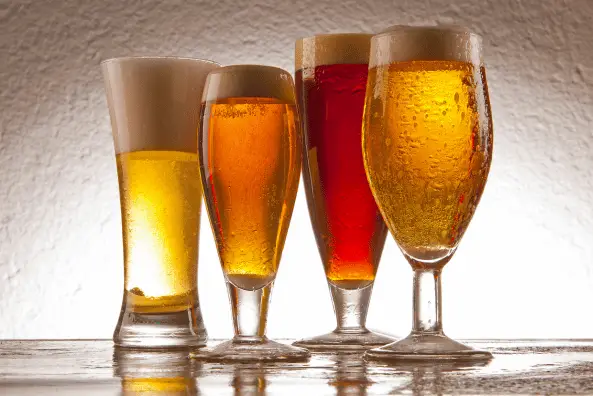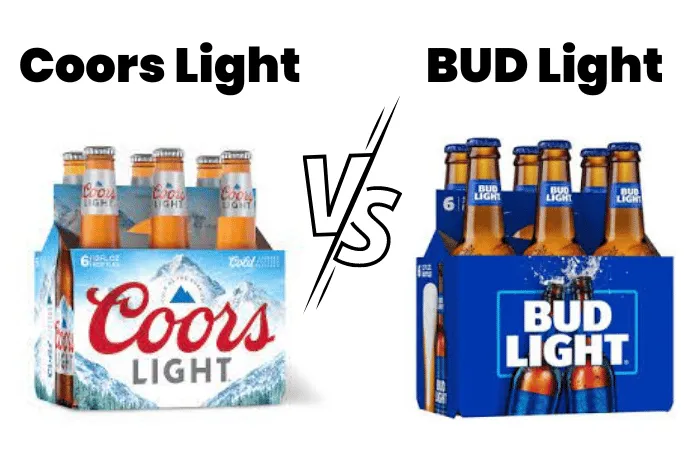In this blog post, we’ll explore how Coors Light and Bud Light stack up against each other. By the end of this post, you’ll better understand what makes these light beers so appealing to consumers and whether they’re worth trying out for yourself.
So grab your favorite pint glass (or can), and let’s settle the Coors Light vs. Bud Light question once and for all!
Table of Contents:
- Origins and History
- Ingredients and Brewing Process
- Flavor Profile and Mouthfeel
- Color
- Alcohol Content & International Bitterness Unit(IBU)
- What People are Saying
- Variations and Brand Loyalty
- FAQs in Relation to Bud Light vs Coors Light
- Conclusion
Origin of Bud Light
Anheuser-Busch brewed Bud Light in St. Louis, Missouri, back in 1876 as Budweiser, and with time it underwent multiple rebrandings until 1982 when the beer was renamed to its current title of “Bud Light.” Its low ABV (alcohol by volume) content of 4.2%, crisp taste profile, and suitability for recreational activities such as camping or barbecues made this beer an instant hit among Americans, who quickly liked it.
Origin of Coors Light
Coors Light also dates back to the 1800s when Adolph Coors created Gablinger’s Diet Beer, which had a lower calorie count than other beers then but still offered an enjoyable flavor profile with 4% ABV content. In 1978, this beer was renamed “Coors Lite” before becoming simply “Coors Light” five years later – giving rise to one of America’s most beloved light beers today. With an ABV of 4.2%, it is slightly higher than Bud Light. Still, it falls into the session-able lagers perfect for everyday drinking occasions with friends or family members.
The popularity of these two brands has made them household names across America and abroad; they are now considered part of “the big three,” along with Miller Lite when talking about light beers from major breweries in the US beer industry. As craft beer continues to gain traction worldwide, these traditional favourites will remain staples among American consumers who prefer something easy-drinking yet flavorful without having too high an alcohol content, making them great choices for any occasion.
Coors Light vs Bud Light: Ingredients and Brewing Process

Beer fans often pick light brews, and two of the most prevalent in America are Bud Light and Coors Light. What specifically goes into making them? Some of the biggest names in the beer industry have been brewing for decades.
Brewing Process of Bud Light
Bud Light uses water, barley malt, hops, and rice. Combining these ingredients produces a light flavor profile with hints of breadiness and malty notes. Hops provide a slight bitterness that helps balance the sweetness of other flavors. It is achieved through fermentation at cooler temperatures (35–50 F).
Brewing Process of Coors Light
Coors Light also uses water from multiple sources combined with hop extract, lager yeast, and corn syrup, giving it slightly sweet bready notes and signature crispness. As with Bud Light, this process involves fermentation at colder temperatures (35 – 50 F), resulting in a lighter-bodied beer than many craft varieties today.
Bud Light and Coors Light offer an easy drinking experience that appeals to those looking for something refreshing without too much complexity or strong flavors. While they may not be everyone’s preference, they remain staples within the larger beer giant portfolios offering consumers familiar options when shopping for their favorite brews.
Components and brewing methods for Bud Light and Coors Light may be similar, yet the resulting flavors can differ significantly. Exploring the distinctions in flavor, let’s delve into how these two beers contrast in taste and texture.
Coors Light vs Bud Light: Mouthfeel, Flavor, and Color
Mouthfeel
Coors Light and Bud Light are two of the most widely consumed light beers, providing a crisp taste with soft aromas and an SRM rating between two to three. Both give drinkers a light, refreshing flavor that is incredibly easy to drink. They have very faint smells and come in transparent yellow, ranking between two to three on the SRM scale.
Flavor of Bud Light
Bud Light has mild breadiness flavors mixed with malty notes & subtle hints of hops, making for an enjoyable drinking experience for those who like their beer on the lighter side. With an alcohol content of 4.2%, this beer is perfect for casual occasions or days when you want something light and tasty.
Flavor of Coors Light
Coors Light offers a slightly different taste than Bud Light due to its higher ABV (alcohol by volume) at 4.2%. It means more calories, approximately 102 calories per can compared to one-and-a-half bananas. It also contains some grainy sweetness, which balances against the hop bitterness, resulting in a smooth finish that lingers longer than BudLight’s aftertaste. Cost-wise, you can expect about $8 for six cans or roughly $3 per tall boy, depending on your location – not bad, considering it’s from one of America’s largest beer giants.
Whether you prefer Coors Light or BudLight really depends on personal preference but both offer great options if you’re looking for something light yet flavorful without breaking the bank.
Color
Regarding color, light beers such as Coors Light, Bud Light, and Miller Lite are transparent yellow, ranking between two to three on the SRM scale. It indicates their pale coloration due to using lighter malted grains during production. For example, a traditional pilsner will have an SRM rating of four or higher because they use more heavily kilned malt in the brewing process, which gives them that golden hue.
Regarding color, Bud Light is a pale golden hue, while Coors Light has a more distinct light yellow tint. Moving on from color, let’s look at the alcohol content and International Bitterness Unit (IBU) of both beers.
Coors Light vs Bud Light: Alcohol Content & International Bitterness Unit

Light beers such as Coors Light, Bud Light, and Miller Lite are staples of the beer industry. They contain similar alcohol content levels ranging from around 4-5% ABV. These light beers also share similar IBUs being less than 10 making them perfect for those who prefer something smooth without any lingering bitterness aftertaste left behind. The quantity of hops used in the brewing process determines the International Bitterness Unit (IBU), which measures the beer’s bitterness.
When looking for a light beer with low IBUs, you should consider brands like Coors Light which offer an easy drinking experience with minimal hoppy notes while still providing a full flavor profile that’s both crisp and refreshing all at once – perfect for summer days. With this information, you can now decide what kind of beer suits your palate best, whether you’re searching for something milder or stronger, depending on your preference.
What People are Saying About Coors Light vs Bud Light
Regarding light beers, Bud Light and Coors Light are two of the most popular choices. Though the two beers have a similar taste and texture, slight variations between them may make one more desirable than the other to certain drinkers.
These light beers are often chosen by nostalgia. Shaun O’Sullivan, the owner of San Francisco’s 21st Amendment Brewery and former home brewer, has been drinking Coors Light since he was legal. He enjoys this beer brand’s taste and childhood memories.
Bud Light and Coors Light have 4% ABV and 110-120 calories per 12 ounces, respectively. O’Sullivan may prefer Coors Light because it’s sweeter and has bready notes, while Bud Light is grainy and corny.
Overall, the opinions about Bud Light and Coors Light vary from person to person. However, there are loyal fans of both brands who appreciate their unique flavor profiles and brewing processes. Turning to distinctions and brand commitment, let’s consider the source and background of these two beers and their components and brewing technique.
Variations and Alternatives to Coors Light and Bud Light
Regarding variations and brand loyalty, several popular light beers have become staples in the beer industry. Bud Light is a well-known beer brand; its iconic blue cans are easily recognizable, and the taste of it is mild. It has several variations, including BudLight Seltzer, BudLight Platinum, and BudLight Chelada. Coors Brewing Company makes popular beers like Coors Banquet, Pure, and Coor’s Edge. Some critics call them “dumb” beers. Still, their unique brewing processes produce distinct flavor profiles and affordability for consumers looking for something refreshing and easy to drink without breaking the bank.
Miller Lite is another popular brand from MillerCoors that uses a combination of six-row barley malts and four types of hops to create its smooth taste and clean finish. Its ABV (alcohol by volume) content varies depending on region but generally falls between 4% – 5%. Miller Lite’s lower ABV makes it a good craft beer introduction compared to IPAs and stouts. Miller Lite’s IBU ranges from 9 to 12, compared to porters and Belgian ales’ 30s or 40s.
Those looking for something even lighter than Miller Lite or Bud Light should consider trying out Keystone Light. In 1989, Coors Brewing Company introduced this beer as an alternative to Bud Light and Miller Lite with a slightly sweeter taste but the same low ABV (4%), low-calorie count (105 per 12oz serving), and low price. Keystone Light may be the perfect option after a chilled beverage at san frills.
FAQs in Relation to Bud Light vs Coors Light
What sells more Bud Light or Coors Light?
Bud Light is the more popular beer of the two, selling significantly more than Coors Light. It can be attributed to Bud Light’s higher marketing budget and wider availability in stores across the United States. Furthermore, Bud Light offers a wider variety of flavors and styles that appeal to a more extensive range of individuals. On top of this, its lower price point also makes it an attractive option for many consumers. Ultimately, these factors combine to make Bud Light the preferred choice over Coors Light among most American beer drinkers.
Is Bud Light healthier than other beers?
No, Bud Light is not necessarily healthier than other beers. Bud Light contains fewer calories and carbohydrates than other beers, but its lower ABV may not be nutritionally superior. Moreover, beer’s nutritional composition can differ significantly based on the ingredients used in production and the brewing techniques utilized. Therefore, it’s impossible to definitively say that one particular beer is “healthier” than another without examining all relevant factors.
Is Coors Light healthier than other beers?
No, Coors Light is not necessarily healthier than other beers. While it has fewer calories and carbohydrates than some light beers, its alcohol content is still relatively high at 4.2%. Coors Light contains sulfites, which can trigger allergic reactions in certain people. Moderation is best when drinking alcohol. Ultimately, the healthiest option when consuming any alcoholic beverage in moderation.
Which has less calories Bud Light or Coors Light?
Bud Light and Coors Light are light beers with lower calorie content than regular beer. Coors Light has approximately 8 fewer calories than Bud Light per 12-ounce can or bottle. Therefore, when comparing these two brands, Coors Light is slightly lower in calories than Bud Light.
Conclusion
In conclusion, Bud Light and Coors Light are two of the most popular beers in the world. They have distinct differences in their origins, ingredients used for brewing, fermentation process, flavor profile, mouthfeel, color, alcohol content, and IBU (International Bitterness Unit). While both offer a light beer experience that many people around the globe can enjoy, they still differ enough to provide an interesting comparison between them. Ultimately, it is up to you which one suits your taste buds better when considering Bud Light vs. Coors Light.
Discover the best beer for your taste buds with our Bud Light and Coors Light reviews. Subscribe to our beer subscription service to access exclusive brewing equipment and learn how to make great-tasting craft beer at home!
